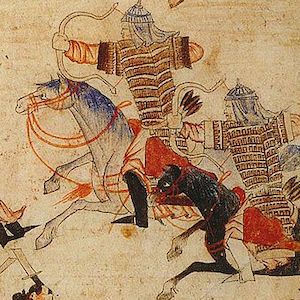Long Teaching Module: Masculinity and Femininity in the Mongol Empire
Overview
This module examines ideals of masculinity and femininity among the Mongols, the Central Asian nomadic pastoralists who in the thirteenth century under their leader Chinggis Khan created the largest land-based empire the world has ever seen. Like all empires, the Mongol Empire was created by military conquest, and men formed the bulk of the fighting force, but women were also important in the empire’s rise and expansion. The characteristics prized in men and women, particularly those at the top of society, were shaped by the traditions of steppe culture and by innovations made by the Mongols. The eight sources for this module include sections from three histories written in the thirteenth or fourteenth centuries, plus two illustrations from one of them.
Essay
Until the last several decades most discussions of men ignored gender. In nineteenth-century Europe and North America, for example, women were often described as “the Sex,” as if men did not have any. Books with titles like Woman in Western Philosophy analyzed gender, while those with titles like Man in Western Philosophy generally did not, although as women’s history developed authors who continued to use “man” tried to argue that this was somehow gender-neutral. (It isn’t.) This situation has changed dramatically, and the study of men as gendered beings and of masculinity has exploded in many academic fields, including history, literature, psychology, sociology, religion, and many others. Because of the long tradition of viewing men as differentiated by race, class, social standing, and other factors, and, because diversity of experience is such a strong emphasis in current gender scholarship, these studies often use the plural “masculinities” rather than the singular “masculinity.” They emphasize that all men construct their masculinity in relation not only to women, but also in relation to other men, and that groups of men also vary widely in their ability to shape their own masculinity depending on their position in racial, class, and other power structures. Although it is the exact counterpart to masculinity, “femininity” has generally not caught on as a term of scholarly study, perhaps because it is still seen as more restrictive and less open to variation than masculinity. “Femininities” is even less common, unless it is paired with “masculinities.” This module does use both “masculinity” and “femininity” in looking at gender ideals among the Mongols, the Central Asian nomadic pastoralists who in the thirteenth century under their leader Chinggis Khan (his title, not his name, and in older scholarship usually spelled “Genghis”) created the largest land-based empire the world has ever seen. Like all empires, the Mongol Empire was created by military conquest, but once the Mongols had conquered an area they had to govern it, which meant they needed to create permanent institutions that would allow them to extract resources from the territories under their control and would keep the population from successfully revolting. Both Mongol conquests and Mongol bureaucracy were shaped by gender. Chinggis Khan reorganized the Mongol army so that warriors did not fight in clan groups, but in groups that combined people from different tribes led by his personal allies, relatives, and in-laws chosen on the basis of merit and loyalty rather than tribal chiefs. Because every Mongol man was a soldier, this reorganization led to social change, as soldiers’ loyalty was transferred from their tribe to their commander and up the chain to Chinggis’s very large extended family. Mongol practices and rituals enhanced male self-esteem and soldiers’ loyalty to one another. As the Mongols expanded their empire, they took a census of all households and required all male adults to register for military conscription. Some of these men were actually drafted into the army, where they were made distinguishable from the rest of the population by an unusual uniform haircut. That marked them anywhere they went as part of a group of men whose function was fighting, no matter what kind of clothing they were wearing; it made desertion more difficult but also allowed soldiers to recognize one another immediately and encouraged bonding within the group. (Distinctive military haircuts continue to serve all these functions.) The Mongols also had a specific type of male bonding, the anda (“sworn friend”) bond in which two men pledged to aid one another under any circumstances, creating a permanent spiritual bond between them, ritually consecrated by an oath. Chinggis Khan himself had anda bonds with leaders from other clans, as did his male relatives and descendants, which shaped their military strategies and alliance networks. Loyalty among men was an important tool in Mongol expansion, and so were other gendered practices. Mongol marital norms forbade marriage to someone from the same clan, so men had to get their wives from other clans and tribes, which they sometimes did by forcibly abducting them. That pattern of exogamy continued as the Mongol Empire grew, and men raped, seized, purchased, and sometimes married women from the groups they conquered. This pattern was particularly evident at the top, as Mongol leaders generally had a number of wives of various ranks and many more women available to them. A widely reported 2003 article from the American Journal of Human Genetics noted that over 8 percent of all males in a broad area of Asia from the Pacific Ocean to the Caspian Sea share the same Y chromosome. The 23 authors of this article concluded that this pattern most likely resulted from the success that Chinggis Khan and his male descendants had in spreading their Y chromosome across Central Asia. If their sample is representative, more than 16 million men today are direct-line male descendants of Chinggis Khan, surely one of the world’s most successful lineages. Chinggis Khan’s female family members and descendants are not traceable through genetic evidence, but other types of sources highlight how important they were in the rise and expansion of the Mongol Empire. His mother Hogelun raised him and his brothers after their father was killed. His senior wife Börte advised him on political matters and managed his camp properties. His daughters married the leader of other steppe tribes, allowing the Mongols to form alliances, as these sons-in-law and then their sons became leaders of large military units. The widows of his sons and grandsons sometimes ruled parts of the empire after the death of their husbands, and carried out campaigns to advance the careers of their sons. The most important of these widows was Sorghaghtani Beki (c. 1190-1252), the widow of Chinggis Khan’s youngest son Tolui and a Nestorian Christian, who administered Tolui’s lands after his death. She successfully influenced family and imperial politics so that all four of her sons became rulers, and supported the Mongol policy of religious toleration. After the death of Chinggis Khan’s son Ogotei in 1241, there were internal quarrels among Mongol leaders about the succession, particularly to the position of ultimate ruler, or Great Khan. Sorghaghtani Beki worked with her husband’s nephew Batu Khan on behalf of her son Möngke to make him the next Great Khan. He ruled from 1251 to 1259. The extensive forced and voluntary migrations of men and women within the Mongol Empire led to sexual relationships and marriage across all kinds of lines—linguistic, cultural, tribal, religious—which served as important means of cultural exchange and hybridization at all social levels from the emperor’s household down. In the western khanates, for example, the first Mongols to accept Islam appear to have been ordinary soldiers who interacted with the largely Muslim indigenous population and married local women. The Mongols who ruled China broke with this pattern, as they wanted to preserve their privileges as conquerors so avoided many Chinese practices and resisted assimilation. They forbade Chinese to marry Mongols, and passed other regulations in an attempt to keep Chinese from passing as Mongols and to keep social groups apart. They assigned people hereditary occupations, each of which carried certain tax or labor obligations, and classified the population into four grades, with the Mongols at the top and the southern Chinese at the bottom. The Mongols were nomadic, and they lacked a tradition of historical and other writings, so we have very few documents produced by the Mongols themselves. In fact, the only extensive historical piece written by Mongols is what has come to be called The Secret History of the Mongols, probably produced by an anonymous court scribe in about 1240. And as its readership was limited to only a small court elite, all copies of the text in Mongolian disappeared, and what survives are Chinese translations and transcriptions. Other sources come from non-Mongols who served closely with them in conquered lands. One of these was Rashid al-Din (ca. 1247-1318), a Persian who served as a high official at the court of the rulers of the Ilkhanate, one of the four divisions of the vast Mongol Empire created after Chinggis Khan’s death. His Compendium of Chronicles (Jami' al-tawarikh), finished around 1310, offers the most detailed account of the Mongols produced by any early writer. Another early account comes from another Persian, Ala ad-Din ‘Ata-Malik Juvaini (1226-1283), who served as an adviser to several rulers of the Ilkhanate and wrote The History of the World Conqueror (Ta’ri ki-i-Jahan-Gusha), focused mainly on the early years of Chinggis’s conquests. This module includes selections from all three of these sources. All of these are written as narrative history, with the authors describing things that have happened, but as I introduce them to students, I emphasize that they also contain much information about Mongol ideals of masculinity and femininity and other aspects of gender. Although the authors do not say “men should be like this” or “women should be like this,” individuals are held up for praise or blame depending on how their actions fit with ideals. The same is true of the two illustrations; they portray events, but also contain prescriptions about how men and women should be. All of the sources relate to Mongol rulers and the female members of their families, so these are ideals for those at the top of society, but they also trickle down.
Primary Sources
Bibliography
Allsen, Thomas T. Culture and Conquest in Mongol Eurasia (Cambridge: Cambridge University Press, 2001). Broadbridge, Anne F. Women and the Making of the Mongol Empire (New York: Cambridge University Press, 2018). Lane, George. Daily Life in the Mongol Empire (Westport, CT: Greenwood, 2006). Weatherford, Jack. Genghis Khan and the Making of the Modern World (New York: Crown, 2005). Weatherford, Jack. The Secret History of the Mongol Queens (New York: Crown, 2011). Zerjal, Tatiana, et al. “The Genetic Legacy of the Mongols,” American Journal of Human Genetics 72 (2003): 717–721.
Credits
Merry Wiesner-Hanks is Distinguished Professor of History at the University of Wisconsin-Milwaukee. She is the long-time senior editor of the Sixteenth Century Journal, an editor of the Journal of Global History, and the editor-in-chief of the nine-volume Cambridge World History (2015). She is an author or editor of more than thirty books and nearly 100 articles that have appeared in English, German, French, Italian, Spanish, Portuguese, Greek, Chinese, Turkish, and Korean. This module was developed for the World History Commons.






